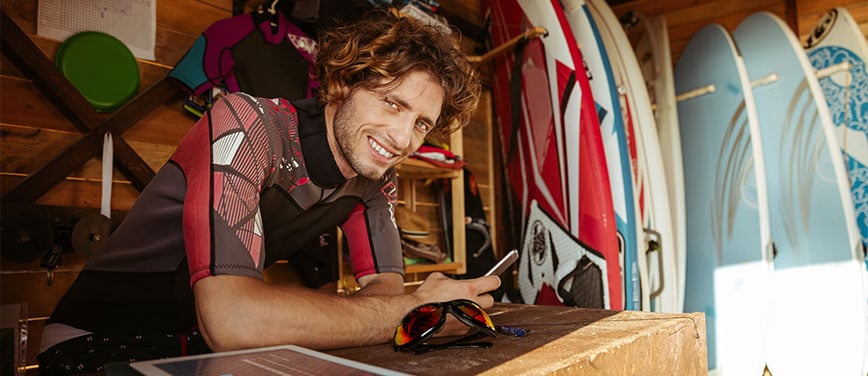Factors that influence the survey duration
1st factor: Target group and accessibility
The accessibility of your target group plays a decisive role in determining the survey duration.
Are the participants online every day or are they difficult to reach?
- If, on the other hand, you are conducting a survey among working people or older people, it may take longer to reach a sufficient number of participants.
- If you are targeting an online community or social media users, you can get many responses within a few days.
Differences between B2B and B2C surveys:
- B2B surveys (business surveys) should run longer, as working professionals have less time and may only participate after several reminders.
- B2C surveys (customer surveys) can often run shorter as consumers respond more quickly.

2nd factor: Survey type
Not every survey requires the same duration.
The type of survey largely determines how long it should remain open.
Internal surveys:
- If you are conducting a survey within a company or a team, 3-7 days is often enough.
- The employees usually have a fixed working day and can respond to the survey relatively quickly.
Customer feedback surveys:
- These should run for around 1-2 weeks to ensure customers have enough time to engage with the survey but don’t lose interest.
Market research surveys:
- These usually take 2-4 weeks to run as a larger sample size is required.
- Participants often have to be reached via various channels first.
Academic studies:
- Academic surveys, especially for theses or research projects, should take 3-6 weeks to complete.
- Specific target groups are often required here, which may only be reached slowly.
Event or product surveys:
- If you are collecting feedback on an event or a new product, 1-2 weeks should be sufficient.
- The feedback is particularly time-critical here and quickly loses its value.
3rd factor: Distribution method
The way in which the survey is distributed has a significant influence on the duration.
Email surveys:
- If you are sending a survey via email, it is advisable to leave it open for at least 7-14 days.
- Many people do not open their emails immediately or need a reminder.
Social media surveys:
- Surveys on platforms like Instagram or Twitter can often run shorter (3-7 days) as users interact in real time and respond quickly.
Face-to-face surveys or telephone interviews:
- These usually take longer, as interview partners have to be found and appointments coordinated.
- Run times of 2-6 weeks are realistic here.
4th factor: Scope of the survey
The length and complexity of the survey also influence how long it should be available.
Short surveys (5-10 questions):
- Can be completed in a few days as they take little time.
- A duration of 5-10 days is often sufficient.
Medium-length surveys (10-30 questions):
- Should run for 1-3 weeks to generate enough responses without overwhelming participants.
Long or complex surveys (over 30 questions):
- These types of surveys often require more time.
- A duration of 3-6 weeks may be required, especially if they contain detailed or scientific questions.
Recommended duration depending on survey type
| Type of survey | Recommended runtime |
|---|---|
| Internal employee survey | 3 – 7 days |
| Customer survey | 1 – 2 weeks |
| Market research survey | 2 – 4 weeks |
| Academic studies | 3 – 6 weeks |
| Event or product survey | 1 – 2 weeks |
Tips to maximize participation
Regardless of the term, there are some proven strategies to increase participation:
- Send regular reminders:
A friendly reminder after a few days can help increase response rates. - Communicate clear deadlines:
When participants know the survey is about to end, they are more likely to respond in a timely manner. - Offer incentives:
Sweepstakes, discounts or small rewards can significantly increase participation rates. - Use multiple channels:
Distribute the survey not only via email, but also via social media or personal networks. - Ensure mobile optimization:
Many people answer surveys on their smartphones – a mobile-optimized version can improve participation rates.
Conclusion: The golden mean counts
The ideal duration of a survey depends on the target group, scope and distribution.
While internal surveys often only take a few days, larger studies can run for several weeks.
It is important to find the balance between getting enough responses and avoiding fatigue.
A well thought-out duration in combination with clever dissemination strategies ensures meaningful results and a high participation rate.
With the right planning, every survey will be a success!
More tips & tricks for surveys
- Evaluating surveys with easyfeedback: Effectively collect and analyze feedback
- Survey or questionnaire? Find out the decisive difference!
- 8 tips for building your questionnaire
- Tips for increasing participation rates in employee and customer surveys
- 10 tips to increase the response rate of your survey
- Tips & tricks to motivate more participants to take part in the survey
- Why you shouldn’t ask as many questions as you like in your survey
- Negative feedback after a survey: how to best deal with it!
- 7 proven practical tips for creating your next questionnaire
- Formulating texts and questions when creating your questionnaire




